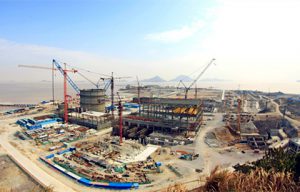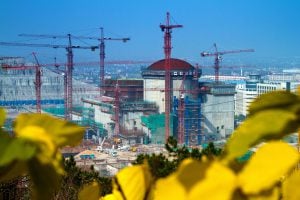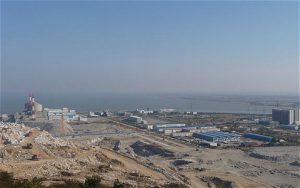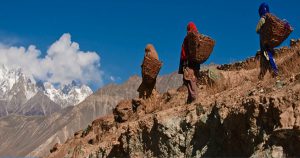China and Russia are building over half of the nuclear power plants under construction in the world. Of 66 reactor projects under way globally, 27 are in China and 10 in Russia. The activity doesn’t stop at home: both countries are very active in financing, building or attempting to sell their nuclear technologies to other countries. While on the surface they have strong and vibrant industries, however, the two dominant nuclear players are also experiencing economic, industrial and societal problems which threaten to dampen their global ambitions.
While China is relatively new to the civil nuclear industry – at the turn of the century it had only three operational units – the sector has grown rapidly in recent years. In 2013, there were 21 operational reactors, although still only providing 2% of the country’s electricity, and in 2014 two additional reactors came on line.
The state has hugely ambitious targets for construction of new nuclear-power plants. By 2030, it wants 200 gigawatts of nuclear capacity up and running, and 400-500 gigawatts by 2050. In the shorter term, it is aiming for 58 gigawatts of operational capacity and a further 30 gigawatts under construction by 2020, head of the China Nuclear Energy Association (CNEA) Zhang Huazhu said in April this year.
Fulfilling this short-term objective would be a remarkable achievement. Notably, however, it is 12 gigawatts below the target recommended by the State Council Research Office (SCRO) in 2011 and a very significant reduction on the prediction of 130 gigawatts suggested by officials the year before that. This decline points to significant issues at home that are working to constrain the construction timetable – and has implications for the industry’s activities abroad.
Setbacks at home
The suspension of new nuclear construction following Japan’s Fukushima disaster in March 2011, which was only lifted in October 2012, partly explains the reduction in ambition. In fact, since March 2011, construction has started on only seven new reactors in China compared to 10 in 2010 alone. While the ban has been lifted, construction inland has not resumed in part due to public concern over the safety implications of the ability to cool the reactor in the event of a major accident at sites dependent upon river water. No construction is expected to take place on new inland nuclear power plants at least until the end of the current five-year plan.
Anti-nuclear protests are also having an impact – following demonstrations in Guangdong province, south China, in July 2013, plans for a fuel-fabrication facility were dropped, according to press reports. And increased environmental awareness more widely is leading to a shake-up of the licensing process. The National Nuclear Safety Administration (NNSA) announced in 2012 that “if the environmental impact report does not have a public participation chapter, NNSA would not accept the report”.
The degree to which public opposition and new licensing processes affect the rate and scale of the deployment of nuclear power in China will probably only become clear during the next five-year plan (2016-2020). What is already evident, however, is the extent of the construction delays already facing the programme: 21 of 27 of the projects are experiencing holdups ranging from a few months to two years including for the most advanced foreign reactors, the French-built European Pressurized Water Reactors (EPR) and the Japanese/American AP1000.
When construction of the Taishan-1 reactor started in November 2009, the EPR was due to be operational by March this year. The launch date is now June 2015. One of the reasons cited for such delays is the knock-on effects from beleaguered projects in Europe – namely at Olkiluoto-3 in Finland and Flamanville-3 in France, both of which are now at least five and seven years behind schedule – leading to an inability to rely on testing and qualification results. By the end of 2013, the construction at the first of AP1000 at Sanmen unit 1, which had begun in March 2009, was at least two years behind schedule and 20% over budget. The delays in completing the engineering stage have been blamed on Westinghouse’s unfamiliarity with Chinese regulations.
Overseas ambitions
While China has so far focused its attention on the domestic market, it is increasingly attempting to export technology and become a strategic investor. Its ability to deliver is therefore taking on a greater global significance.
The largest sale to date has been to Pakistan, where China National Nuclear Corporation (CNNC) is constructing two 340-megawatt reactors at Chashama and has a contract for two further 1,000-megawatt reactors at Karachi, a deal which includes a US$6.5 billion loan.
More recently, in July 2014, China Nuclear Power Engineering Co. (CNPEC) is said to have struck a deal with the Canadian company CANDU Energy, for the completion of two reactors at the Cernavoda power plant in Romania. In the same month, China and Argentina signed an agreement that would see CNNC provide goods and services, under a long-term financing agreement for another CANDU reactor.
Finally, and most striking, in the UK China General Nuclear Power Group (CGN) and CNNC have taken a 30-40% share of the proposed £16 billion Hinkley Point C project for the construction of two EPR reactors, which are awaiting approval from the European Commission. This deal will, it is said by the project’s main constructor, France’s AREVA, “give CGN and CNNC the opportunity to gain experience in the UK and will support their long-term objective of becoming established nuclear developers in the UK.
Russian parallels
In Russia, too, there is a new confidence emanating from the nuclear industry. The country is seeking to increase its domestic production (in 2013, 17.5% of the country’s electricity came from nuclear) as well as its global influence, through the export of reactors backed by financing.
In total, around 30 Russia-linked reactors are under construction or planned globally, which makes Russia by far the largest international nuclear exporter. In Europe, the country is involved in construction or bidding for projects in Hungary, Finland and Belarus. Russia is also actively engaged in a project in Turkey, while two of its reactors are in operation in China and another two under construction. Elsewhere in Asia, there are proposals for Russian reactors in Bangladesh, India and Vietnam.
But, also like China’s case, the buzz abroad may conceal a more fragile industry at home. Russia has 10 reactors listed as under construction. But three of these were started in the 1980s, while all of the others are either currently suspended or running at least two years late. Two are, in fact, “floating reactors”, small 32-megawatt units. Ordered in February 2009, they were expected to be delivered to the customer at the end of 2012, but are now forecast to start up in late 2016. At the most recent new project, the Baltic-1 unit, where construction started in February 2012, work has now stopped.
As in China, targets for the deployment of new units have continually been downgraded. In September 2006, Rosatom announced a target for nuclear power to provide 23% of electricity by 2020 and the operation of 44 gigawatts of capacity – twice as much as in 2014. By July 2012, this had been scaled back to suggest that there would be 30.5 gigawatts of nuclear in 2020. This will require little more than the completion of the 9 reactors currently under construction.
As with other sectors of civil society and the environmental movement, anti-nuclear activists have been targeted by the Russian administration in recent months and years. In 2012 the Russian Duma adopted a law which required NGOs receiving funding from overseas and engaged in “political activities” to register as “foreign agents”, which requires additional reporting and the hiring of specialist staff to cope with the increased bureaucracy. Then, in June 2014, the Ministry of Justice began unilaterally to declare organisations as “foreign agents”, including Ecodefense, one of Russia’s oldest environmental campaign groups. One of the reasons given by the Ministry of Justice for this was Ecodefense’s opposition to the Baltic nuclear-power plant.
Despite, and in some ways because of these domestic challenges, the Russian industry is pushing ahead with its export ambitions. But it remains uncertain how many of these projects will actually be completed successfully. Russia’s economy was badly hit by the 2008-09 economic crisis and the Ukraine conflict is taking an additional toll on its financial and political situation. Two Russian reactors scheduled to be built at Khmelnitsky in Ukraine, for example, may well be derailed by political tensions.
Without doubt China and Russia are potentially the two most important countries for the nuclear industry given the scale of their domestic markets and export ambitions. However, both are developing their nuclear sectors under quite different parameters and regulations than those experienced in many countries to which they are seeking to export, including financial regulation, public participation and independence of the licensing process and the electricity market.
While extremely favourable financial terms might in the short term facilitate nuclear sales, in the medium to longer term, full access to a highly competitive and limited global market will require much greater domestic reform and transparency.
This article is based on material from the World Nuclear Industry Status Report 2014. The writers are the report’s lead authors.







